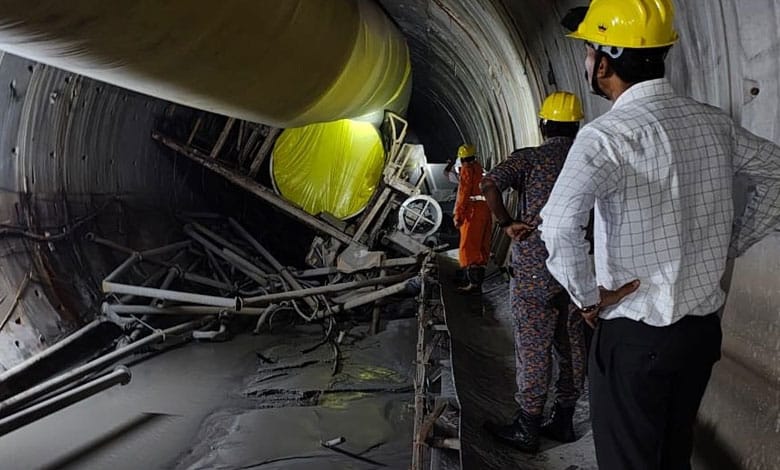Tunnel Tragedy in Telangana: Fault Zone Ignored, Lives Lost
The tragic SLBC tunnel collapse, which claimed the lives of eight workers, has intensified scrutiny on Jaiprakash Associates for alleged negligence in addressing long-flagged geological risks.

Hyderabad: The tragic SLBC tunnel collapse, which claimed the lives of eight workers, has intensified scrutiny on Jaiprakash Associates for alleged negligence in addressing long-flagged geological risks. As rescue operations to locate the six remaining workers have been called off, government officials and experts are raising serious concerns about safety, accountability, and the lack of due diligence in the project’s execution.
Table of Contents
Jaiprakash Associates Ignored Fault Zone Risks, Reports Say
A senior official from the Irrigation Department of Telangana confirmed that the collapse site—13.9 km inside the Srisailam Left Bank Canal (SLBC) tunnel—was located within a known fault zone. The area was explicitly identified as geologically unstable in multiple Tunnel Seismic Prediction (TSP) reports, including a critical 2020 study by Amberg Tech AG.
Also Read: Congress Accuses Opposition of ‘Insensitive Politics’ Over Hyderabad Fire Incident
“The incident could have been avoided. The location was flagged for water-bearing zones and fractured rock mass years ago,” the official stated.
The TSP-303 Plus system used in the 2020 study pinpointed dangers like reduced rock stiffness, jointed formations, and high water seepage potential—all of which were ignored before resuming work in early 2025.
SLBC Collapse Timeline: Known Danger Ignored
- February 22, 2025: A maintenance operation to repair a water leak leads to a three-meter roof collapse inside the SLBC tunnel.
- Casualties: Eight workers are trapped under debris and floodwaters; rescue efforts have since ceased.
- Prior Warnings: TSP reports from 2020 and 2022, including warnings from the Geological Survey of India (GSI) and National Geophysical Research Institute (NGRI), highlighted the same fault-prone zone.
A 2020 research paper co-authored by a former GSI official and a Jaiprakash Associates geologist admitted that tunneling began without full subsurface exploration, relying instead on remote sensing due to environmental restrictions in the Amrabad Tiger Reserve.
Project Oversight and Legal Accountability Under the Scanner
The Telangana government has held Jaiprakash Associates contractually liable for the tragedy and its financial fallout. Questions remain about whether the agency shared seismic findings with the government or incorporated them into its construction risk strategy.
“There was no review of the 2020 report before work resumed. That alone reflects a glaring failure in oversight,” the official added.
Call for Accountability and Tunnel Safety Reform
The SLBC tunnel collapse has reignited calls for:
- Mandatory pre-tunneling seismic audits
- Transparent project risk assessments
- Accountability for private contractors
- Enhanced worker safety measures
The tragedy highlights a dangerous pattern in infrastructure project management, where cost and timeline pressures override geological realities, placing workers’ lives at risk.
